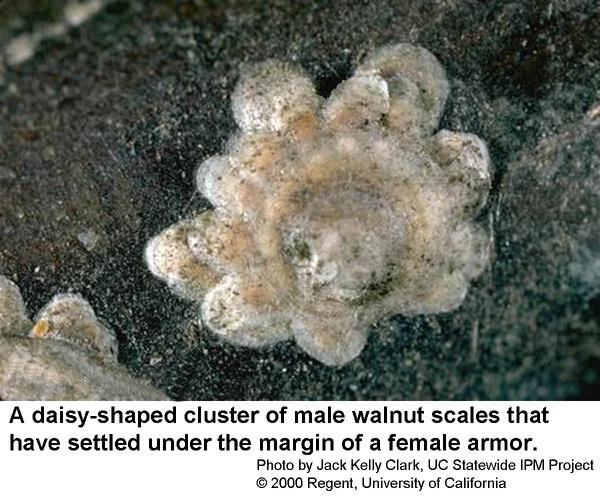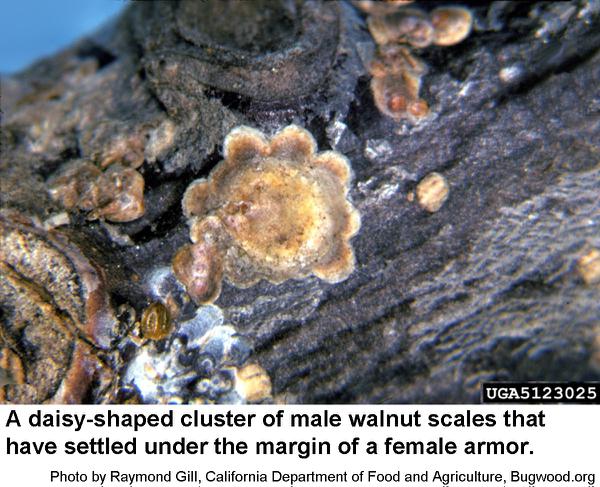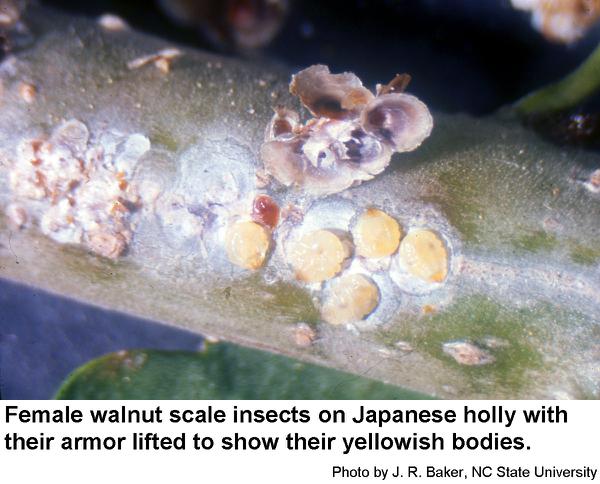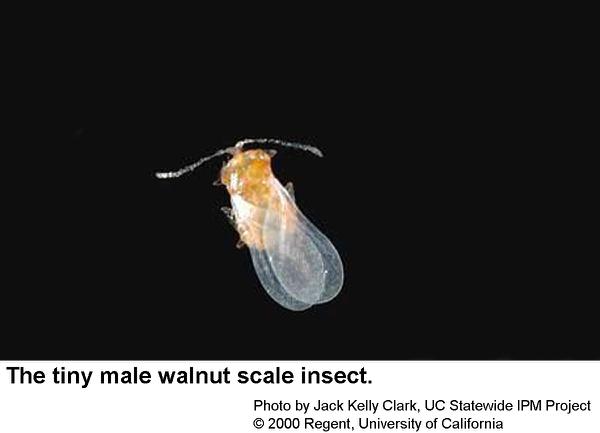Description and Biology
The armor of female walnut scales, Quadraspidiotus juglansregiae, is 1/8 inch wide, nearly circular, flat, and gray with a reddish brown spot. The females's body underneath is yellowish with indented margins. An unusual feature of walnut scales is that they sometimes occur in daisy-shaped groups when male crawlers settle under the margin of the circular female cover and begin forming their elongated armor. Walnut scale has two generations a year. It overwinters as second stage immature females and males. In spring, both sexes resume development and mature at the same time. Adult males emerge from the scale covering as tiny two-winged insects that mate with the mature females. After mating, females lay eggs in mid May and eggs hatch 2 to 3 days later. Crawlers move around the branches for a short time in mid May before they settle down, begin feeding, and secrete the scale cover. Male crawlers sometimes move to the margins of a female armor and settle down. Initially the scale armor is white (white cap stage), but it changes to gray or brown after about a week. The first generation completes development by mid July, and females lay eggs in mid August. These eggs hatch and the crawlers are active in late August to early September before they settle down, secrete their armor and molt once before winter. Walnut scales are not considered serious pests in Florida although in Maryland they have caused noticeable dieback or even death of their host trees and shrubs.
Host Plants
Walnut scale insects infest a wide variety of deciduous trees and shrubs including boxwood, camellia, cherry, dogwood, hollies, peach, plum, red maple, sweetgum, tuliptree, and walnut. It infests some conifers only rarely. Heavily infested plants look water stressed and branches may die back from the tips when encrusted with scale insects. Extremely heavy populations can cause the bark to crack.
Residential Recommendations
At least six species of parasitic wasps prey upon walnut scales. including some in the genera Aphytis and Encarsia. The twice-stabbed lady beetle and other lady beetles also feed on walnut scales. The wasps and lady beetles usually control low to moderate population levels of the walnut scale. Walnut scale is susceptible to horticultural oils. It would be well to use the 2% rate to prevent phytotoxicity to the host plant. Make sure the tree is well irrigated before treating them to prevent the pesticide from damaging the plant. If the tree is too large to spray, a systemic insecticide can be applied to the soil beneath to be translocated up inside the tree to the scales.
References
- Armored Scale Identification and Management on Ornamental Plants. Frank, S. 2010. Entomology Insect Notes, NC State Extension Publications.
- Florida Armored Scale Insects. Dekle, G. W. 1965. Arthropods of Florida and Neighboring Land Areas, Vol 3. 265 pp.
- Horticultural Oils for Ornamental Plants. Steven Frank, S., J. R. Baker, S. Bambara. 2018. Entomology Insect Notes, NC State Extension Publications.
- Walnut Scale, Quadraspidiotus juglansregiae. Grant, J. A. et al. 2017 (updated). UC IPM Pest Management Guidelines: Walnut. UC ANR Publication 3471.
- Walnut Scale. Larson, J. L. 2021 (revised). Entomology at the University of Kentucky, UK College of Agriculture, Food and Environment. Insect and Pest Info. ENTFACT-436.
- Extension Plant Pathology Publications and Factsheets
- Horticultural Science Publications
- North Carolina Agricultural Chemicals Manual
For assistance with a specific problem, contact your local N.C. Cooperative Extension Center.
This Factsheet has not been peer reviewed.
Publication date: Sept. 12, 2017
Revised: June 15, 2022
Recommendations for the use of agricultural chemicals are included in this publication as a convenience to the reader. The use of brand names and any mention or listing of commercial products or services in this publication does not imply endorsement by NC State University or N.C. A&T State University nor discrimination against similar products or services not mentioned. Individuals who use agricultural chemicals are responsible for ensuring that the intended use complies with current regulations and conforms to the product label. Be sure to obtain current information about usage regulations and examine a current product label before applying any chemical. For assistance, contact your local N.C. Cooperative Extension county center.
N.C. Cooperative Extension prohibits discrimination and harassment regardless of age, color, disability, family and marital status, gender identity, national origin, political beliefs, race, religion, sex (including pregnancy), sexual orientation and veteran status.





